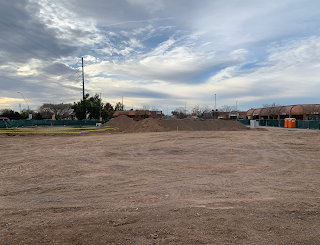Phoenix, Arizona in the 1920s
One of the things that I find fascinating about my adopted home of Phoenix, Arizona, is that it's constantly changing. I've lived here since I was a teenager, and believe me, it's not the same. I've spoken to people older, and younger, than me, and they say the same. What happened to the buildings they remember?, that sort of thing.
As my studies of Phoenix history has slowly progressed, I have found myself lately exploring Phoenix in the 1920s. And if you really want to see changes in Phoenix, look at the difference that happened before and after World War I.
During World War I, from 1914 to 1918, the economy of Phoenix was booming because of the demand for long-staple cotton, also known as Pima Cotton and Egyptian Cotton. The demand was driven by the wartime need for tires, which relied on this very strong cotton at the time. Yes, tires. I'm not kidding, this cotton was used mainly for tires. Go Google it, I'll wait.
But after the war ended, the price of cotton plummeted. So by 1919, and the 1920s, the economy of Arizona, and Phoenix, was in big trouble. And the demand for oranges had gone down, too, because of competition by places like Florida, and Southern California. In fact, an entire county south of Los Angeles was dedicated to growing oranges, a lot of them. So two of the big Cs of the Arizona economy, cotton and citrus, were slipping badly.
Another important factor in Phoenix, and in the entire United States in the 1920s, was the Prohibition of Alcohol. And while it wouldn't have mattered before then, as Phoenix began to emphasis tourism, it did then. Like in the rest of the country, Prohibition encouraged bootlegging (the illegal selling of alcohol), and organized crime. So, while tourism brought a much-needed spur to the economy of Phoenix, it also brought crime with it.
And as in the rest of the country, the thought was to borrow money to stimulate the economy. So Phoenix grew, with many spectacular buildings, and neighborhoods, that exist to this day. The old-timers may have despaired at seeing their once-classic city suddenly turn into a series of neighborhoods of the (then ridiculed) Spanish Colonial style, or the showy tall buildings of downtown Phoenix.
History buffs know what happened in 1929, the worst economic crash in the history of the United States, leading to the Great Depression of the 1930s. And Phoenix "froze in time" during that era, and wouldn't recover until after World War II, in 1945. Then Phoenix woke up and reinvented itself all over again, and continues to do so.
Pictured above, the Roosevelt Hotel, actually named the Westward Ho when it was built. Built in the 1920s, and for many years afterward the tallest building in Phoenix, Central and Fillmore.
If you liked this article, and would like to see more, please consider becoming a patron of History Adventuring on Patreon. If you're already a patron, thank you! You make this happen!
Click here to become a Patron!
History adventuring posts are shared there daily. The basic tier is a dollar a month, and the PhD tier, which includes "then and now" photos, billboards, aerials, videos, and super high-definition photos, is five dollars a month, and is discounted for seniors, veterans, and students.




Always wondered, where the heck was the Roosevelt Hotel? Now I know, the Westward Ho
ReplyDelete